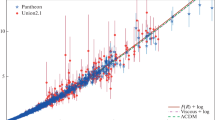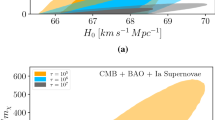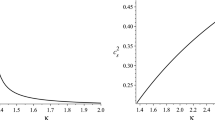Abstract
The tension between the value of the Hubble constant \(H_0\) determined from local supernovae data and the one inferred from the cosmic microwave background based on the \(\Lambda \)CDM cosmological model may indicate the need for new physics. Here, we show that this ‘Hubble tension’ can be resolved in models involving an effective energy flux from the matter sector into dark energy resulting naturally from a combination of unimodular gravity and an energy diffusion process. The scheme is one where dark energy has the standard equation of state \(w=-1\). This proposal provides an alternative phenomenological paradigm accounting for the observations, while offering a general framework to study diffusion effects coming from novel fundamental physical processes.







Similar content being viewed by others
References
Planck Collaboration, Adam, R., et al.: Planck 2015 results. I. Overview of products and scientific results. Astron. Astrophys. 594 (2016) A1, arXiv:1502.01582
Planck Collaboration, Aghanim, N., et al., Planck 2018 results. VI. Cosmological parameters. arXiv:1807.06209
BOSS Collaboration, Alam, S., et al., The clustering of galaxies in the completed SDSS-III Baryon Oscillation Spectroscopic Survey: cosmological analysis of the DR12 galaxy sample. Mon. Not. Roy. Astron. Soc. 470 (2017) 2617–2652, arXiv:1607.03155
Riess, A.G., Casertano, S., Yuan, W., Macri, L.M., Scolnic, D.: Large magellanic cloud cepheid standards provide a 1% foundation for the determination of the hubble constant and stronger evidence for physics beyond \(\Lambda \)CDM. Astrophys. J. 876, 85 (2019). arXiv:1903.07603
Reid, M., Pesce, D., Riess, A.: An improved distance to NGC 4258 and its implications for the hubble constant. Astrophys. J. 886, L27 (2019). arXiv:1908.05625
Freedman, W.L., et al.: The Carnegie-Chicago Hubble Program. VIII. An Independent Determination of the Hubble Constant Based on the Tip of the Red Giant Branch. arXiv:1907.05922
Farr, W.M., Fishbach, M., Ye, J., Holz, D.: A future percent-level measurement of the hubble expansion at redshift 0.8 with advanced LIGO. Astrophys. J. 883, L42 (2019). arXiv:1908.09084
Bergström, L.: Nonbaryonic dark matter: Observational evidence and detection methods. Rept. Prog. Phys. 63, 793 (2000). arXiv:hep-ph/0002126
Clifton, T., Ferreira, P.G., Padilla, A., Skordis, C.: Modified gravity and cosmology. Phys. Rept. 513, 1–189 (2012). arXiv:1106.2476
Martin, J.: Everything you always wanted to know about the cosmological constant problem (But Were Afraid To Ask). Comptes Rendus Phys. 13, 566–665 (2012). arXiv:1205.3365
Supernova Search Team, Riess, A.G., et al.: Observational evidence from supernovae for an accelerating universe and a cosmological constant. Astron. J. 116 (1998) 1009–1038, arXiv:astro-ph/9805201
Supernova Cosmology Project, Perlmutter, S., et al.: Measurements of Omega and Lambda from 42 high redshift supernovae. Astrophys. J. 517 (1999) 565–586, arXiv:astro-ph/9812133
Bernal, J.L., Verde, L., Riess, A.G.: The trouble with \(H_0\). JCAP 1610, 019 (2016). arXiv:1607.05617
Freedman, W.L.: Cosmology at a crossroads. Nat. Astron. 1, 0121 (2017). arXiv:1706.02739
Poulin, V., Smith, T.L., Karwal, T., Kamionkowski, M.: Early dark energy can resolve the hubble tension. Phys. Rev. Lett. 122, 221301 (2019). arXiv:1811.04083
Colgáin, E.Ó., van Putten, M.H., Yavartanoo, H.: de Sitter Swampland, \(H_0\) tension & observation. Phys. Lett. B793, 126–129 (2019). arXiv:1807.07451
Kumar, S., Nunes, R.C., Yadav, S.K.: Dark sector interaction: a remedy of the tensions between CMB and LSS data. Eur. Phys. J. C 79, 576 (2019). arXiv:1903.04865
Di Valentino, E., Melchiorri, A., Mena, O., Vagnozzi, S.: Interacting dark energy after the latest Planck, DES, and \(H_0\) measurements: an excellent solution to the \(H_0\) and cosmic shear tensions. arXiv:1908.04281
Agrawal, P., Obied, G., Vafa, C.: \(H_0\) Tension, Swampland conjectures and the epoch of fading dark matter. arXiv:1906.08261
Rossi, M., Ballardini, M., Braglia, M., Finelli, F., Paoletti, D., Starobinsky, A.A., Umiltà, C.: Cosmological constraints on post-Newtonian parameters in effectively massless scalar-tensor theories of gravity. Phys. Rev. D 100, 103524 (2019). arXiv:1906.10218
Josset, T., Perez, A., Sudarsky, D.: Dark Energy from Violation of Energy Conservation. Phys. Rev. Lett. 118, 021102 (2017). arXiv:1604.04183
Collins, J., Perez, A., Sudarsky, D., Urrutia, L., Vucetich, H.: Lorentz invariance and quantum gravity: an additional fine-tuning problem? Phys. Rev. Lett. 93, 191301 (2004). arXiv:gr-qc/0403053
Collins, J., Perez, A., Sudarsky, D.: Lorentz invariance violation and its role in quantum gravity phenomenology. arXiv:hep-th/0603002
Perez, A., Sudarsky, D.: Dark energy from quantum gravity discreteness. Phys. Rev. Lett. 122, 221302 (2019). arXiv:1711.05183
Perez, A., Sudarsky, D., Bjorken, J.D.: A microscopic model for an emergent cosmological constant. Int. J. Mod. Phys. D 27, 1846002 (2018). arXiv:1804.07162
Perez, A., Sudarsky, D.: Black holes, Planckian granularity, and the changing cosmological ’constant’. arXiv:1911.06059
Banerjee, S., Benisty, D., Guendelman, E.I.: Running vacuum from dynamical spacetime cosmology. arXiv:1910.03933
Ellis, G.F.R., van Elst, H., Murugan, J., Uzan, J.-P.: On the trace-free Einstein equations as a viable alternative to general relativity. Class. Quant. Gravit. 28, 225007 (2011). arXiv:1008.1196
Weinberg, S.: The cosmological constant problem. Rev. Mod. Phys. 61, 1–23 (1989)
Sorkin, R.D.: Causal sets: discrete gravity. arXiv:gr-qc/0309009
Jacobson, T.: Thermodynamics of space-time: The Einstein equation of state. Phys. Rev. Lett. 75, 1260–1263 (1995). arXiv:gr-qc/9504004
Jacobson, T.: Entanglement equilibrium and the Einstein equation. Phys. Rev. Lett. 116, 201101 (2016). arXiv:1505.04753
Benisty, D., Guendelman, E.I.: Interacting diffusive unified dark energy and dark matter from scalar fields. Eur. Phys. J. C 77, 396 (2017). arXiv:1701.08667
Benisty, D., Guendelman, E., Haba, Z.: Unification of dark energy and dark matter from diffusive cosmology. Phys. Rev. D 99, 123521 (2019). arXiv:1812.06151
Eppley, K., Hannah, E.: The necessity of quantizing the gravitational field. Found. Phys. 7, 51–68 (1977)
Page, D.N., Geilker, C.D.: Indirect evidence for quantum gravity. Phys. Rev. Lett. 47, 979–982 (1981)
Carlip, S.: Is quantum gravity necessary? Class. Quant. Gravit. 25, 154010 (2008). arXiv:0803.3456
Maudlin, T., Okon, E., Sudarsky, D.: On the status of conservation laws in physics: implications for semiclassical gravity. arXiv:1910.06473
Amadei, L., Perez, A.: Hawking’s information puzzle: a solution realized in loop quantum cosmology. arXiv:1911.00306
Amadei, L., Liu, H., Perez, A.: Unitarity and information in quantum gravity: a simple example. arXiv:1912.09750
Perez, A.: No firewalls in quantum gravity: the role of discreteness of quantum geometry in resolving the information loss paradox. Class. Quant. Gravit. 32, 084001 (2015). arXiv:1410.7062
Perez, A.: Black holes in loop quantum gravity. Rept. Prog. Phys. 80, 126901 (2017). arXiv:1703.09149
Perez, A., Sahlmann, H., Sudarsky, D.: On the quantum origin of the seeds of cosmic structure. Class. Quant. Gravit. 23, 2317–2354 (2006). arXiv:gr-qc/0508100
León, G.: Eternal inflation and the quantum birth of cosmic structure. Eur. Phys. J. C 77, 705 (2017). arXiv:1705.03958
Okon, E., Sudarsky, D.: Benefits of Objective Collapse Models for Cosmology and Quantum Gravity. Found. Phys. 44, 114–143 (2014). arXiv:1309.1730
Okon, E., Sudarsky, D.: The black hole information paradox and the collapse of the wave function. Found. Phys. 45, 461–470 (2015). arXiv:1406.2011
Modak, S.K., Ortíz, L., Peña, I., Sudarsky, D.: Non-paradoxical loss of information in black hole evaporation in a quantum collapse model. Phys. Rev. D 91, 124009 (2015). arXiv:1408.3062
Bedingham, D., Modak, S.K., Sudarsky, D.: Relativistic collapse dynamics and black hole information loss. Phys. Rev. D 94, 045009 (2016). arXiv:1604.06537
Okon, E., Sudarsky, D.: Losing stuff down a black hole. Found. Phys. 48, 411–428 (2018). arXiv:1710.01451
Bassi, A., Ippoliti, E., Vacchini, B.: On the energy increase in space-collapse models. J. Phys. A Math. General 38, 8017–8038 (2005)
Visser, M.: Jerk and the cosmological equation of state. Class. Quant. Gravit. 21, 2603–2616 (2004). arXiv:gr-qc/0309109
Aviles, A., Gruber, C., Luongo, O., Quevedo, H.: Cosmography and constraints on the equation of state of the Universe in various parametrizations. Phys. Rev. D 86, 123516 (2012). arXiv:1204.2007
Bruni, M., Lazkoz, R., Rozas-Fernandez, A.: Phenomenological models for Unified Dark Matter with fast transition. Mon. Not. Roy. Astron. Soc. 431, 2907 (2013). arXiv:1210.1880
Akarsu, O., Barrow, J.D., Escamilla, L.A., Vazquez, J.A.: Graduated dark energy: observational hints of a spontaneous sign switch in the cosmological constant. arXiv:1912.08751
Cattoen, C., Visser, M.: The Hubble series: Convergence properties and redshift variables. Class. Quant. Grav. 24, 5985–5998 (2007). arXiv:0710.1887
Dunsby, P.K.S., Luongo, O.: On the theory and applications of modern cosmography. Int. J. Geom. Meth. Mod. Phys. 13, 1630002 (2016). arXiv:1511.06532
García-Aspeitia, M.A., Martínez-Robles, C., Hernández-Almada, A., Magaña, J., Motta, V.: Cosmic acceleration in unimodular gravity. Phys. Rev. D 99, 123525 (2019). arXiv:1903.06344
Riess, A.G., et al.: Type Ia supernova distances at redshift \(>\) 1.5 from the Hubble Space Telescope multi-cycle treasury programs: the early expansion rate. Astrophys. J. 853, 126 (2018). arXiv:1710.00844
Camarena, D., Marra, V.: Local determination of the Hubble constant and the deceleration parameter, arXiv:1906.11814
Camarena, D., Marra, V.: A new method to build the (inverse) distance ladder. arXiv:1910.14125
Colgáin, E.Ó.: A hint of matter underdensity at low z? JCAP 09, 006 (2019). arXiv:1903.11743
Lusso, E., Piedipalumbo, E., Risaliti, G., Paolillo, M., Bisogni, S., Nardini, E., Amati, L.: Tension with the flat \(\Lambda \)CDM model from a high-redshift Hubble diagram of supernovae, quasars, and gamma-ray bursts. Astron. Astrophys. 628, L4 (2019). arXiv:1907.07692
Yang, T., Banerjee, A., Colgáin, E. O.: On cosmography and flat \(\Lambda \)CDM tensions at high redshift. arXiv:1911.01681
Velten, H., Gomes, S.: Is the Hubble diagram of quasars in tension with concordance cosmology?. arXiv:1911.11848
Fukugita, M., Hogan, C.J., Peebles, P.J.E.: The Cosmic baryon budget. Astrophys. J. 503, 518 (1998). arXiv:astro-ph/9712020
Nicastro, F., et al.: Observations of the missing Baryons in the warm-hot intergalactic medium arXiv:1806.08395 [Nature558,406(2018)]
Bregman, J.N., Anderson, M.E., Miller, M.J., Hodges-Kluck, E., Dai, X., Li, J.-T., Li, Y., Qu, Z.: The extended distribution of Baryons around galaxies. Astrophys. J. 862, 3 (2018)
García-Aspeitia, M.A., Hernández-Almada, A., Magaña, J., Motta, V.: On the birth of the cosmological constant and the reionization era. arXiv:1912.07500
Acknowledgements
We thank Marco de Cesare and Violaine Ponsin for help with the figures, and E.W.-E. thanks Aix-Marseille Université for hospitality during the initial stages of this work. E.W.-E. is supported in part by the Natural Science and Engineering Research Council of Canada and by a Harrison McCain Foundation Young Scholars Award. D.S. acknowledges partial financial support from PAPIIT-UNAM, Mexico (Grant No. IG100120); the Foundational Questions Institute (Grant No. FQXi-MGB-1928); and the Fetzer Franklin Fund, a donor advised by the Silicon Valley Community Foundation. D.S. acknowledges partial financial support from PAPIIT-UNAM, (México) Grant No. IG100120; CONACYT ( México) project “Frontiers of Science” No 140630; the Foundational Questions Institute (Grant No. FQXi-MGB-1928); and the Fetzer Franklin Fund, a donor advised by the Silicon Valley Community Foundation.
Author information
Authors and Affiliations
Corresponding author
Additional information
Publisher's Note
Springer Nature remains neutral with regard to jurisdictional claims in published maps and institutional affiliations.
Rights and permissions
About this article
Cite this article
Perez, A., Sudarsky, D. & Wilson-Ewing, E. Resolving the \(H_0\) tension with diffusion. Gen Relativ Gravit 53, 7 (2021). https://doi.org/10.1007/s10714-020-02781-0
Received:
Accepted:
Published:
DOI: https://doi.org/10.1007/s10714-020-02781-0




